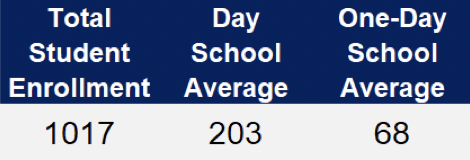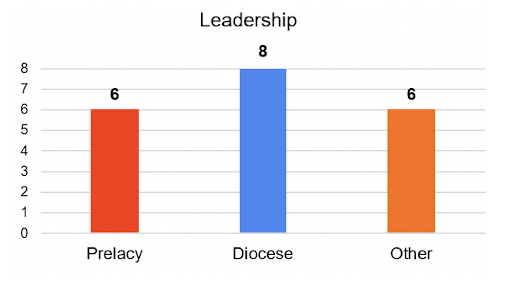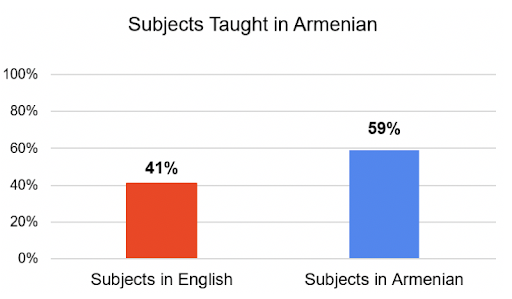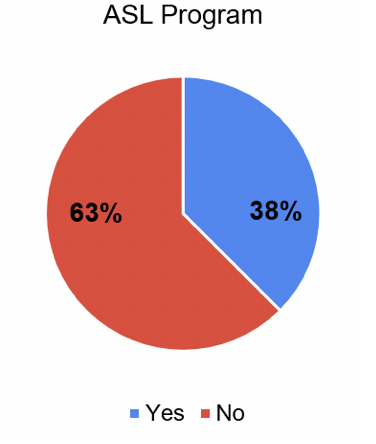OVERVIEW
The Central Language Council (CLC) is a newly-formed central council of the Armenian Youth Federation–Youth Organization of the Armenian Revolutionary Federation (AYF-YOARF) Eastern Region. Its mission is to empower Armenian youth through the promotion of Armenian language use. As the representative of youth within the vibrant and evolving Armenian language space, CLC has a lot to learn from established organizations and institutions already working to cultivate our mother tongue in the diaspora.
CLC would like to recognize the formative and foundational role played by Armenian schools and their tremendously selfless faculty in serving as the bastions of Armenian language preservation and cultivation in the Eastern US for over a century. From small 15-student Saturday workshops to 700-student day schools, the self-sacrifice embodied by our largely volunteer Armenian teaching corps is in many ways unrivaled. Accordingly, we owe it to our teachers and our young Armenian-American generation to commit our communities to the pursuit of Armenian excellence through well-resourced and community-supported Armenian schools.
To this end, it is the objective of this report to turn the community’s eyes toward our schools in appreciation for where we are and in dedication to where we need to go. The report is a product of qualitative and quantitative data compiled from nine interviews, which included both day and one-day schools from all affiliations; these schools teach both Eastern and Western Armenian.
CLC hopes that readers who engage with the report can develop a closer and more profound understanding of where and how the Armenian language is taught, the challenges Armenian schools and educators face, and the implemented and potential strategies that will serve to ensure a 21st century Armenian-American generation that lives with and takes ownership of its mother tongue.
EXECUTIVE SUMMARY
This report seeks to ask and offer solutions to the following central question: how can our communities better support our schools based on their needs? First, big picture quantitative data on enrollment, teachers, curriculum and leadership is presented to depict the status of our schools in broad strokes. This data is then further detailed by what our school leaders expressed as four key challenges facing their institutions today: adapting to the pandemic, maintaining alumni engagement, providing engaging content and creating an environment for conversational Armenian. To address these and other challenges, the report communicates four opportunities for action that are in large part informed by school leader recommendations and best practices. Lastly, CLC presents its current role in the space and its next steps with a new Armenian book club and a virtual fundraiser.
BY THE NUMBERS
The CLC interviewed three day schools and six one-day schools. Please note that there are a total of five day schools and 15 one-day schools in the eastern region and the data shown below only includes data collected from the nine schools interviewed (exception: figures shown for “School Leadership” include data that was collected outside of interviews). Also note that “day school” refers to schools that provide instruction five days a week, while “one-day school” refers to Saturday or Sunday schools with Armenian language instruction.





KEY CHALLENGES
In addition to collecting quantitative data, CLC sought out the most pressing challenges facing school leaders and identified four key areas.
Administrative
Challenge 1: Adapting to the Pandemic
Since the start of the pandemic, Armenian schools across the eastern region have experienced a hit in enrollment. More so than day schools, the pandemic has disproportionately affected one-day schools, which already struggle with low attendance and limited resources. Two one-day schools, for example, cited that their enrollment dropped by over 45 percent. While enrollment is expected to bounce back with a return to in-person learning, it is unclear how the negative impact of the pandemic on Armenian schools will affect attendance long-term. (See Opportunity 2).
Challenge 2: Maintaining Alumni Engagement
Educators repeatedly pointed toward a large gap in Armenian language exposure and retention experienced by Armenian-American students that takes place between graduation from Armenian school and “re-entry” into the Armenian language after college. Only two schools run until 12th grade in the region. This means that the vast majority of students stop Armenian language learning at 8th grade or below. Graduation from Armenian school is a crucial time to commit to the retention and application of language skills, especially for students who don’t live in Armenian-speaking households. However, the challenge of engaging alumni in Armenian school life post-graduation has been widely experienced in the region. (See Opportunity 3)
Pedagogical
Challenge 3: Providing Engaging and Culturally Relevant Content
Educators communicated that students are likely to learn best when the content is culturally relevant to their lived experiences. However, there seems to be an insufficient amount or overall lack of awareness surrounding ways to access content that speaks to the 21st century Armenian-American student. Engaging textbooks with culturally relevant short stories were frequently mentioned as difficult to locate, especially in Western Armenian. As a result, 50 percent of interviewed schools expressed that they have decided to teach some extent of Armenian history, literature or religion in English. (See Opportunity 1 and 4).
Challenge 4: Creating an Environment for Conversational Armenian
While students demonstrate strong reading and writing ability, educators discussed the central difficulty of helping students reach a conversational level of speaking Armenian. This challenge is compounded by the fact that Armenian proficiency is highly variable even within the same age group and that students have limited exposure to conversations in Armenian outside of school. (See Opportunity 1 and 3).
OPPORTUNITIES FOR ACTION
Despite the challenges of the pandemic, educational leaders in our community found creative ways to adapt and support our youth in Armenian language learning. The following opportunities for action stemmed from a diverse set of educators across the eastern region and can be applied not just to school settings, but Armenian communities as a whole.
Opportunity 1: Rethink Curriculum
-
- Leverage Fun: Support learning through exposure, games, content creation and entertainment in the school environment rather than repetition and rote memorization to better engage students.
- Use Translation: Employ English-Armenian and Armenian-English translations as a means to strengthen students’ bilingualism.
- Be Relatable: Include Armenian-American Armenian language content, especially produced by Armenian-American youth, in class syllabus.
- Diversify Mediums: Support textbook readings with content from different mediums such as newspapers (old and new), poetry, songs, academic journal articles, program reports, legal writing (laws, case decisions, etc.), primary source texts, etc.
- Organize Competitions: Organize Armenian language competitions both within and between schools, like Armenian spelling bees, poetry recitations (asmoonk), creative writing, oration, geography, history, etc.
- Innovative Examples in the Community
-
- New pedagogical training that focuses on reimagining language instruction is taking place for Armenian language teachers via Zoom.
- Online exercises are being used instead of “paper and pencil” workbooks to provide students with easy-to-access practice.
- A school has students place Armenian and English versions of the same text next to each other when practicing reading in order to employ “learning through translation.”
- Book talks have been held with new Armenian-American authors of Armenian language content, but their work has yet to enter school curriculums.
Opportunity 2: Support the Next Generation of Educators
-
- Support Educators: Provide financial support or scholarships to students who want to pursue education and pedagogy, especially in the Armenian language.
- Be Open: Support the experimentation of new pedagogical methodologies.
- Provide Incentives: Attract and retain young talent by providing competitive pedagogical training, continuing education, mentorship, and pay or perks.
- Build Partnerships: Build stronger working relations between Armenian schools and Armenian Studies departments of universities that provide programs and resources for Armenian language teaching credentials.
- Innovative Example in the Community: A school runs a teacher’s assistant program for upperclassmen and alumni to gain experience teaching Armenian language.
Opportunity 3: Reimagine Language Retention
-
- Engage Alumni: Develop programs to engage alumni who move on to middle school, high school or college and don’t actively use their Armenian until they become parents.
- Connect Alumni: Take advantage of videoconferencing to convene alumni in an Armenian language environment post-graduation.
- Foster Relations: Foster stronger relations between alumni and current students in mentoring, career development and professional capacities that center around Armenian language conversations, presentations and discussions.
- Innovative Example in the Community: A school has a theater group with alumni who put on periodic plays in Armenian.
Opportunity 4: Boost Attendance through Coalition Building
-
- Recruitment: Develop stronger relations with Armenian youth groups to recruit students
- Public Relations: Recruit the help of young Armenian community members to produce promotional videos and other content to market school to wider community.
- Accessibility: Provide support for families who live far but want their children to learn Armenian by offering transportation stipends, a school bus, carpool facilitation, etc.
- Innovative Example in the Community: A school has regular and constant relations with its local AYF chapter and leans on them for support in various school activities.
The AYF’s Role
As the newly-formed Central Language Council of the AYF-YOARF Eastern Region, we are eager to play an active role in increasing the use of Armenian language throughout our region. We have been hosting a weekly conversation hour called “Զրոյց Մրոյց – Zruyts Mruyts” for AYF members. We also introduced an Armenian language booth at the 2021 AYF Senior Olympics in Providence, Rhode Island and conducted an Armenian language workshop at the 2021 AYF Senior Seminar in Franklin, Massachusetts.
On December 1st, we launched an Armenian-language e-book club called “Ընկերական Գրադարան – Ungeragan Krataran.” This program will serve two main goals: 1) improve participants’ Armenian language proficiency by reading and critically engaging with Armenian literature and 2) learn about Armenian literature by contextualizing author biographies and discussing narratives.
CLC would also like to announce that the AYF will be organizing a virtual fundraiser on social media named «Դէպի Դպրոց – Tebi Tbrots». All proceeds will go to an “Armenian School Tuition Scholarship” that will support selected Armenian-American youth in attending an Armenian school in their area.
With this report and “Tebi Tbrots,” the AYF-YORF Eastern Region has taken its initial steps in building partnerships with our schools and teachers—an endeavor we are very excited to continue pursuing.
| State | City | Type | Name | Year Founded |
| Massachusetts | Watertown | Day School | St. Stephen’s Armenian Elementary School | 1984 |
| Michigan | Southfield | Day School | AGBU Alex and Marie Manoogian School | 1969 |
| New Jersey | New Milford | Day School | Hovnanian School | 1976 |
| New York | Bayside | Day School | Holy Martyrs Armenian Day School | 1967 |
| Pennsylvania | Radnor | Day School | Armenian Sisters Academy | 1967 |
| Maryland | Bethesda | One-Day | Hamasdegh School | 1968 |
| Washington, DC | Tenleytown | One-Day | Shnorali School | 1973 |
| Florida | Boca Raton | One-Day | St. David’s Armenian School | – |
| Florida | Hollywood (Miami) | One-Day | St. Mary’s Armenian School | – |
| Illinois | Chicago | One-Day | Taniel Varoujan Armenian School | 1966 |
| Maryland | Baltimore | One-Day | Baltimore Armenian School | 1986 |
| Massachusetts | Watertown | One-Day | St. James’ Armenian School | 1923 |
| Massachusetts | Watertown | One-Day | St. Stephen’s Armenian Saturday School | 1937 |
| Michigan | West Bloomfield | One-Day | ARS Zavarian Armenian School | 1942 |
| New Jersey | Ridgefield | One-Day | Nareg Armenian School | 1960 |
| New Jersey | Paramus | One-Day | Sipan Armenian School | 1978 |
| New Jersey | Tenafly | One-Day | Kirikian Armenian School of St. Thomas Armenian Church | 1961 |
| New Jersey | Fair Lawn | One-Day | St. Leon Armenian School | 1935 |
| New York | Woodside | One-Day | St. Illuminator Armenian School | – |
| Philadelphia | Pennsylvania | One-Day | Haigazian Armenian School | 1938 |
| Rhode Island | Providence | One-Day | Mourad Armenian Saturday School | 1934 |
| Rhode Island | Providence | One-Day | Sts. Sahag and Mesrob Armenian School | 2016 |
"The Armenian Weekly," December 28, 2021
No comments:
Post a Comment